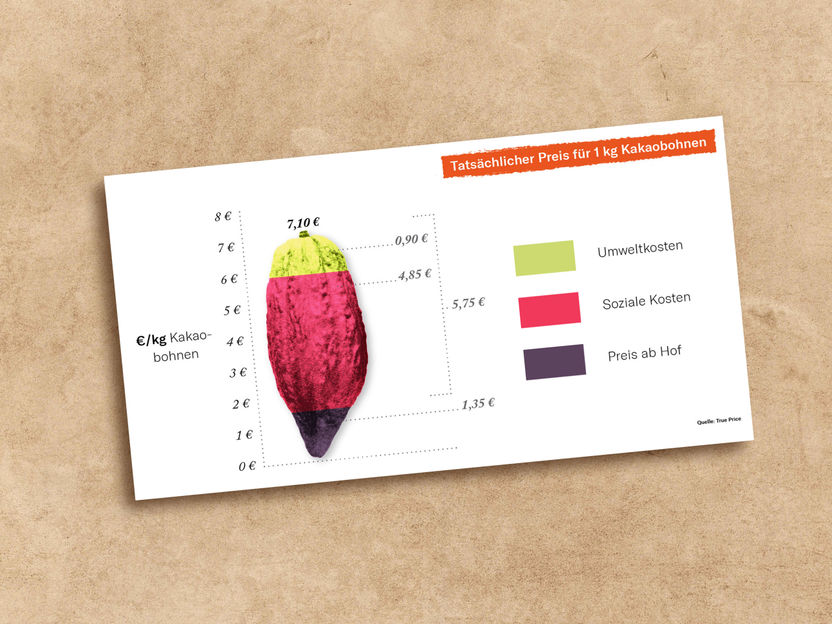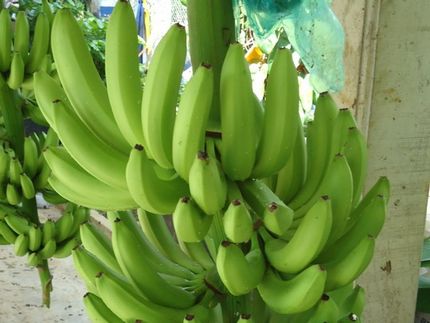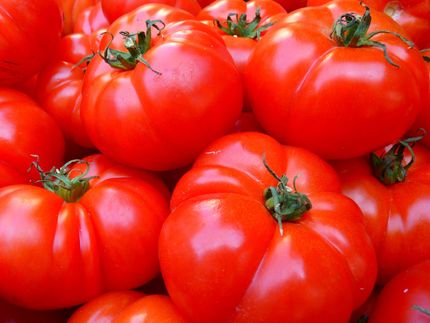What does food "really" cost?
Advertisement
climate change, obesity, child labour, plastic pollution and so on - these are all problems and costs that we do not take into account when buying food. How can these hidden costs be integrated so that we pay the real price for our food and thus fully cover the real costs of our food?

Actual price for 1kg cocoa beans
Jamie Burton, FoodUnfolded® | pixabay
Recently, the news reported on a German supermarket that puts two price tags on its offerings - one for the price due at the checkout and another for the "real price" . That is, the price that takes full account of the social and environmental impact of producing, say, a chocolate bar or a banana. The German supermarket asked researchers from the Universities of Augsburg and Greifswald to calculate the real cost of 16 specific products. The result? Gouda cheese should actually be 88% more expensive and a kilo of minced meat even an astonishing 173%! For fruit and vegetables, the differences are not quite so serious: 19% for bananas, 12% for tomatoes and only 6% for apples. The difference for organic produce is also smaller, but even in that area, organic meat would actually have to be sold at a whopping 126% premium to cover all the hidden costs. 1,2
How can the true cost of food be calculated?
Calculating the true price of a product is a complex matter because: To do this, you first need to know all the things that need to be taken into account in the calculation. Environmentally harmful factors such as CO2 and nitrogen emissions? The energy consumed, the consequences of overfertilization? And what about social costs such as working conditions and child labor? How can factors like these be narrowed down in numbers?
If we want to compare the consumer price of a product with the true price, we can use two different concepts: The "farm gate" price means the price at which the product is available directly from the producer, i.e. excluding separately invoiced transport and delivery costs.3 Then there are the "external costs" of cultivation, which form the "true price differential". This refers to costs of economic activities that are not reflected in the "farm gate" price. External costs, if they have a direct impact on the environment, can also be classified as "environmental costs". However, if they have a direct impact on the well-being of people, they are referred to as "social costs".4
Incidentally, the German researchers are not the first to attempt a calculation of this kind: for some time now, scientists from a wide range of disciplines have been looking for ways to decipher external costs. The Dutch organisation True Price, for example, has been working on calculating the true costs of different products since 2012 and is now a global leader with its tools for measuring and monetising the social impacts of products.
Together with Sustainable Trade Initiative (IDH), True Price has published four review studies on the true costs of coffee, cocoa, cotton and tea, providing a clear listing of 14 different types of external costs, split between environmental and social costs.5
These studies are a good example of how the true cost of food can be calculated in a simple way. The fact that each of the four food products studied scored differently on these 14 aspects highlights that the true cost of a product may not always depend on the same factors. For example, the true cost of a particular food product may be linked to environmental costs, while those for other products may in turn depend on the social costs associated with manual labour.
The true price of cocoa
If we look at cocoa grown in Côte d'Ivoire, we find that the calculated price of conventional cocoa beans is €7.10/kg. This is the sum of the farm gate price (€1.35/kg of cocoa beans) and the external cost of cultivation or true price differential (€5.75/kg of cocoa beans). The true price differential here is more than four times higher than the farm gate price of cocoa beans, again showing that the farm has huge hidden costs as far as the market price is concerned.
Social costs account for 84% of the total external costs of cocoa farming. Environmental costs, on the other hand, are relatively low, mainly related to the sparse pesticide and fertilizer treatments and the extremely low to non-existent water and energy use in cultivation. The actual cost of coffee from Vietnam, on the other hand, is largely determined by environmental factors such as water use and pollution. As you can see, it's relatively hard to know how much which product should cost. But if we work on it step by step, over time we can definitely develop an understanding of what we should really pay for a cup of coffee or a bar of chocolate.6
Why is it important to know the true cost of food?
Alright, now we have at least a basic grasp of what the true cost is. But why is it important to know how much we should pay for a particular product? The reason given by the German supermarket for displaying the true cost alongside the market price is to raise awareness among its customers.7 But according to True Price, that's not the only reason why it's crucial to map all those extra costs.
"The intention behind True Price is to manage risk, drive innovation, and reduce environmental and social costs through improved transparency throughout a product's supply chain."
In other words, the information provided in this way benefits not only end consumers, but also businesses, as by knowing the external costs, they are able to improve the environmental and social impacts of their operations and supply chain, enabling them to develop more sustainable and cost-effective production alternatives.8
But how might this information be applied to truly influence food production and consumption?
A case for the carbon tax:
Since it is unlikely that affected companies will switch to sustainable production on their own, the German scientists advise the introduction of a CO2 tax. This would help to distribute the costs in such a way that all participants along the value chain pay their share. This would allow companies to decide whether to pass on the external costs - i.e. the actual production costs they bear themselves - to consumers or to try to eliminate these costs. A CO2 tax would also mean that polluting companies would have to pay more, while companies investing in more environmentally friendly production would be given preferential treatment.9
The German study shows: If we were to pay for the true costs of products, organic food would actually become cheaper than conventionally produced goods in the long run - because the true price differential is reduced due to the external costs of organic products, which are hardly significant.
The same is true for "fair trade" products, which tend to be a bit more expensive but have a much smaller price differential because their external costs are already reflected in the production chain - as is the case with organic products. As a study published in 2017 by True Price and the British organization Trucost shows, "Fair Trade" bananas have 45% lower costs than the sector average.10 This is because Fair Trade pays farmers a better farm-gate price for their produce.
So with the help of such a tax, dirt-cheap produce would suddenly become incredibly expensive. Clearly, a carbon tax would not be easy to implement in our globalised world. After all, it would require new international legislation to raise the bar for everyone.11
How supermarkets are raising general awareness of the true costs:
Although it is difficult to move the food system towards fair pricing, more and more experiments like that of the German supermarket are sprouting up. Swedish supermarket The Carbon Store, for example, has become the first in the world to introduce a carbon tax to make its customers more aware of the impact of their food purchasing decisions - with CO2 as its "store currency": those who shop at this store have a weekly budget of 18.9kg of carbon dioxide. Yet foods with a high carbon footprint - such as animal products - are more expensive than their vegetarian counterparts. The company believes that this practice will open the eyes of many to how certain purchasing decisions affect their own carbon footprint. The hope behind this is that providing a "footprint budget" will cut the climate impact of shopping cart contents in half.12 In comparison, a Danish supermarket has launched an app that shows customers the estimated carbon footprint of their products.13 In addition, many other brands have announced plans to add carbon footprint information to their products.14
_____
- Andreas Krämer (2020). PENNY labels its first products with "true prices". REWE Group. Accessed on 10 November 2020.
- Anne-Sophie Brändlin (2020). Why cheap groceries will hurt us all in the long run. DW. Accessed on 1 October 2020.
- Glossary of Statistical Terms. Farm Gate Price. OECD. Accessed on 18 November 2020.
- Vincent Fobelets, Adrian de Groot Ruiz. The True Price of Cocoa from Ivory Coast (2016). Joint report by IDH and True Price. Accessed on 1 October 2020.
- Vincent Fobelets, Adrian de Groot Ruiz. The True Price of Cocoa from Ivory Coast (2016). Joint report by IDH and True Price. Accessed on 1 October 2020.
- Leonardo Verkooijen, Adrian de Groot Ruiz, Vincent Fobelets. The True Price of Coffee from Vietnam (2016) Joint report by IDH and True Price. Accessed on 1 October 2020.
- The true cost of our food (2020) MISEREOR. Accessed on 10 November 2020.
- The external cost of banana production: a global study. Fairtrade International. Accessed 18 November 2020.
- Jelle Goossens. De échte prijs van ons eten. Eos Tracé (2018). Accessed 1 october 2020.
- Mandy Parrett. New Food Magazine. New Store in Sweden Prices Good Based on Carbon Emissions (2020). Accessed on 10 November 2020.
- Ali Withers. Checking in on the climate as you check out (2020) Washington Post. Accessed 10 November 2020.
- Agata Wolk-Lewanowicz. Carbon footprint labelling - a growing trend among consumer goods companies (2020). ICIS. Accessed 18 November 2020.<
Note: This article has been translated using a computer system without human intervention. LUMITOS offers these automatic translations to present a wider range of current news. Since this article has been translated with automatic translation, it is possible that it contains errors in vocabulary, syntax or grammar. The original article in German can be found here.

























































